- Merge - The passage of two or more aircraft from front to front. One expression used is "highway style", which indicates two aircraft passing each other left side to left side like two cars on a one lane highway.
- Separation - Distance between an attacker and defender. Can be lateral, longitudinal, or vertical.
- Lead Turn - A turn designed to decrease angle-off prior to passing a bandit's 3/9 line. This move is executed when the bandit is approximately 30° off attacker's nose.
- Closure (Vc) - Relative velocity of one aircraft in relation to another or closure between fighter and target expressed in knots, relative velocity. To make it easier, add the smash of the two jets together when they are flying towards each other or the difference when flying away from each other. This is how you get the closure rate. Example: jet 1 doing 400 kts + jet 2 doing 500 kts = 900kts closure.
- Nose low lead turn
- Nose level lead turn
- Vertical lead turn
Head-on BFM
There he is. A contact has shown up on your RWR and is approaching you! This is where Head-on BFM comes into play. In a shocking study done by the US Navy Fighter Weapons School (Top Gun), It was found that 80% of kills where achieved after the first turn. That means that the very first turn that you make is your most critical. That turn will set up the rest of the fight.
Any angles you give the bogey on the first
pass will haunt you for the rest of the fight.
Lieutenant Jim "Huck" Harris, USN - Navy Fighter Weapons School Instructor
Head-on BFM is probably the hardest BFM to fly as it requires the most attention to your situation (known as Situational Awareness). Head-on BFM will be used the most in the head-2-head arena as two forces approach each other. If you have flown Internet play on KALI, you know what I mean. This subject will discuss the approach to the bandit in 1v1 terms. Detection and approach to the bandit from a distance will be discussed in the ACM section of the series.
After the initial merge, Head-on BFM uses a combination of offensive and defensive BFM. Part of the regimen involves something called an escape window. The escape window deals with knowing when and where to leave the fight. As this is a game concerning h2h, I will not discuss this subject because well, this is h2h! This will be the longest subject, so I hope I don't bore you. Let me get a few terms out of the way first.
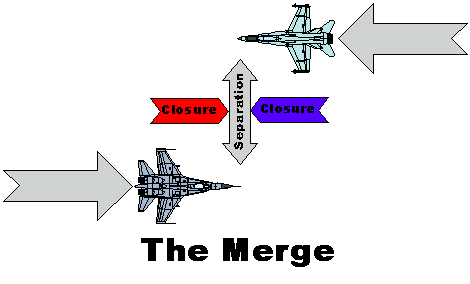
To start you off, you must decide what you are going to do BEFORE you get in to weapons range with the bandit. He may try to get a guns shot on you at the merge, so you need to have a plan before you get there. If you want to stay away from the guns shot (and I recommend this as you can get hit too), you must maintain a certain amount of separation from the bandit at the merge. If he tries to track you, increase your separation from the bandit. Don't over do it though, as this will ruin your lead turn. Your goal is to survive the merge and maneuver to his six. At the merge, you will have three options for your lead turn. Remember that you must fly BFM in the future and head-on is no different. Actually, even more so than in the other forms of BFM. You need to predict where the bandit is going and fly your jet based on that prediction. You want to nose-on the bandit before he gets you. Note this: Padlock must be used in head-on BFM or you will most likely be riding a silk elevator to the ground. You must maintain a tally on the bandit at all times. Loose sight, loose the fight. As I said before, you have three options at the merge:
The purpose of the lead turn is to get your nose on the bandit quickly (let's face it, you can not shoot the guy when your flying AWAY from the bandit. That's the other game...) so that you can shoot him and get it over with. Lead turns are usually performed prior to the bandit passing your 3/9 line. You must again make your best, tightest turn. In the figure below, the hornet performs a lead turn on the SU-27 pulling behind his 3/9 line. The hornet executed the turn when the bandit's LOS increased across his canopy.
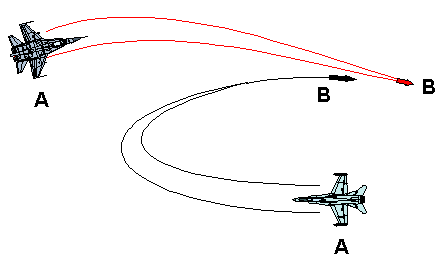
In this figure though, the hornet started his lead turn (B) into the SU-27 too early. Be careful when performing a lead turn. If you lead turn too soon, you may be pulling bullets out of your...well you get the picture (C).
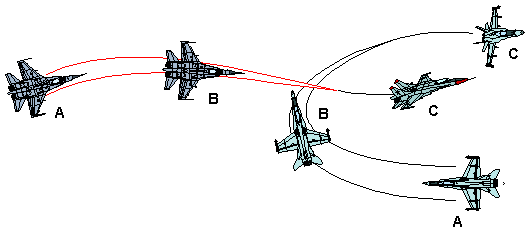
Another place to use the lead turn is in the vertical, also known as the "nose-high-to-nose-low pass". The nose low fighter is the fighter with his nose BELOW the horizon and the nose high fighter's nose is above the horizon. Even if you are higher than the bandit is and your nose is pointed down, you are considered the nose low fighter. In this case, the nose high fighter has the advantage. The nose high fighter should pull a max-g vertical lead turn on the nose low fighter. This will give the nose high fighter that extra g on the down side and leave the nose low fighter to fight that pushing g while trying to pull up into you. This is illustrated in the figure below.
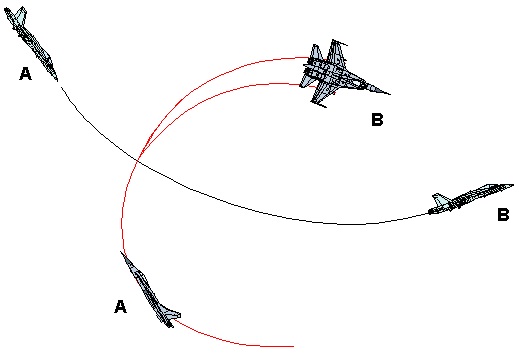
But let's get back to the different types of lead turns. First, let's start with the nose low lead turn. This turn is also commonly called a "Slice". To do a slice, roll your jet greater than 90° but less than 180° . Start your lead turn at around 8 g's into the bandit with your nose approximately 10° nose low to the horizon. Do not start your lead turn until the bandit's line of site rate increases. Remember that you can gain a 2° rate of turn increase on the bandit just by lowering your nose to the horizon in a turn. If you are flying against the same type of aircraft, this may be your only advantage. The advantages of the slice are a high turn rate and the ability to maintain smash. The main disadvantage of the slice is that it is a nose low turn, which can chew up your altitude.
The next turn is the nose level turn. This is the basic "pull your nose across the horizon" lateral turn. When the bandit's LOS rate increases across the canopy, turn your jet 90° to put your lift vector on his noggin and pull, pull, pull. You must perform these turns at corner velocity to get your best turn. You will pay for this turn though, trading energy for position and a slower turn rate. This turn is illustrated below.
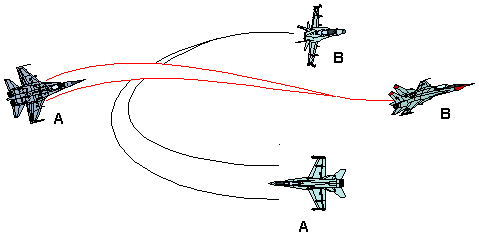
Your last option is to go pure vertical. There are some special cases when the vertical is an appealing move. The best is when you have the sun in front of you. If you pull into the sun, the bandit will have a hard time finding you giving you the time and turning room you need to get angles on him. Another excellent time would be when you have an initial speed advantage over the bandit when entering into the fight, such as 200kt to 300kts. This is discussed in more detail in the section "The Energy Fight". Increase your speed to about 500 to550 kts (Remember that corner velocity rides around 300 to 320 kts.) and roll your wings level pulling straight up. No fancy turns, just straight up. Find the bandit, rotate your lift vector right on his noggin, and pull on him. Fighting in the vertical takes a lot out of your jet. You will have an awful turn rate at the start, but will gain that final increased turn performance as you rotate and nose down with that downward pushing G. If the bandit sees you though, you may fall prey to the nose-low-to-nose-high fight. If the bandit goes up with you, it will be a race to the top, who ever gives up first will lose. Remember this: the only way to defend against the lead turn is to perform a lead turn yourself. Again, you are trading energy for nose position.
After the merge, you will turn and so will the bandit. If he doesn't, he doesn't want to live for too long. There are two types of turn circles. Remember from the Defensive BFM section, turn circles are circles flown in the sky. They are the One-Circle fight and the Two-Circle fight. Both have specific applications. Let's go to the One Circle fight first. One Circle fights are initiated when both fighters turn away from each other. Either you or the bandit can force the fight either one or two circle. A one-circle fight should be used in two cases. When you either have the turn radius advantage or you want to jam the bandit in to Rmin so he can not take a missile shot. In order to force the one circle fight, you will have to minimize the separation between your jet and the bandit's at the merge.
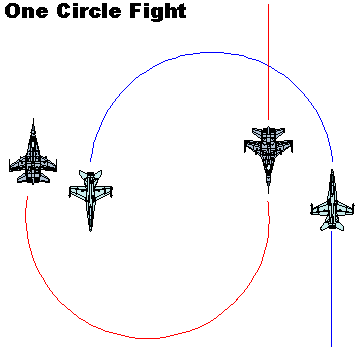
The two-circle fight is performed when you and the bandit fly towards each other. You should go two circle if you have the turn rate advantage. This could even be between the same type of aircraft if he comes into the fight to slow or fast. To initiate the two-circle fight, maximize separation at the merge and then perform your best corner velocity turn when the bandit's LOS increased across your canopy. Two circle fights allow the faster turning fighter to get a 9mike shot across the circle. You can actually come to a neutral position after the two-circle starting the head-on fight all over again. If you have more energy than the bandit, take it two circle again. You will be able to pull on him this time.
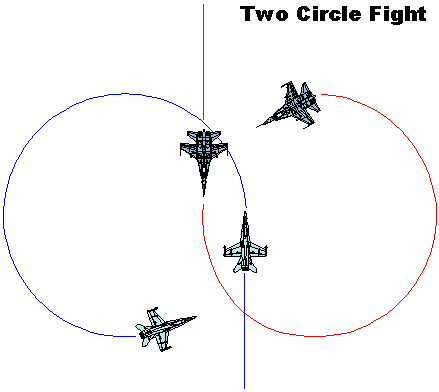
Look at this. A bandit comes into the fight fast, say at 500 to 550 kts, and you are at corner. His speed will increase his turn radius. You want to keep this fight horizontal. And since you are at corner, you will be able to pull a tighter turn than he will. You will be able to get the missile shot first. But what if you come into the fight fast? You can increase separation and go vertical to get turning room. You don't want to give him the horizontal turning advantage up front. If you take the fight vertical, you will have the nose high advantage. A word of advice though, once you start the turn, follow through with it. If you try to reverse the turn or separate, you will ride the silk elevator to the bottom floor. Remember that your first turn is the door to winning or losing.
Well, this concludes the sections on BFM. Hope the information was helpful (please send me email and let me know). As I said before, these modules will be constantly updated as I get more time. Next is Air Combat Maneuvering(ACM).